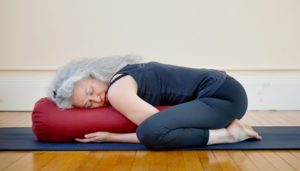Protect the Aging Brain with Yoga
By John M. de Castro, Ph.D.
“We’ve all known yogis who seemed to defy the hands of time. The current study is just one of a long list of studies indicating that yoga may promote healthy aging. Whether it be more growth hormone or less stress, a well-balanced yoga practice is good for you.” – Grace Bullock
Human life is one of constant change. We revel in our increases in physical and mental capacities during development, but regret their decreases during aging. The aging process involves a systematic progressive decline in every system in the body, the brain included. Starting in the 20s there is a progressive decrease in the volume of the brain as we age. But, the nervous system is a dynamic entity, constantly changing and adapting to the environment. It will change size, activity, and connectivity in response to experience. These changes in the brain are called neuroplasticity.
Over the last decade neuroscience has been studying the effects of contemplative practices on the brain and has identified neuroplastic changes in widespread area. and have found that meditation practice appears to mold and change the brain, producing psychological, physical, and spiritual benefits. In addition, they have been able to investigate various techniques that might slow the process of neurodegeneration that accompanies normal aging. They’ve found that mindfulness practices reduce the deterioration of the brain that occurs with aging restraining the loss of neural tissue. Indeed, the brains of practitioners of meditation and yoga have been found to degenerate less with aging than non-practitioners.
In today’s Research News article “Greater Cortical Thickness in Elderly Female Yoga Practitioners—A Cross-Sectional Study.” See summary below or view the full text of the study at: https://www.ncbi.nlm.nih.gov/pmc/articles/PMC5476728/, Afonso and colleagues recruited women over 60 years of age with at least 8 years of Hatha yoga practice and a group of women, matched for age, education and physical activity, who had never practiced yoga, meditation, or other mind-body practices. They were measured for their ability to perform daily tasks of living, depression, and cognitive function. All participants underwent brain scanning with Magnetic Resonance Imaging (MRI).
They found that the yoga practitioners had significantly greater cortical thickness in the frontal lobes than the control group while there were no areas where the yoga practitioners had significantly less cortical thickness. Hence, the practice of yoga appears to protect the prefrontal cortical areas from age related degeneration. This replicates previous findings that mindfulness practices, in general, increase the size of the prefrontal cortex. The prefrontal areas are important for high level thinking, including attention, behavioral inhibition, and executive functions. Hence, their preservation is important for the maintenance of cognitive ability with aging. So, the practice of yoga should be viewed as an important means to preserve the brain and mental ability and thereby age successfully.
So, protect the aging brain with yoga.
“scientifically and medically, most of the claims made for yoga practice stand up. The benefits on both body and mind are legion. The anti-ageing impact is profound. Doing yoga reduces back pain, improves balance and muscle strength and reverses muscle loss. It improves symptoms of rheumatoid arthritis, menopausal symptoms, even the control of type 2 diabetes. It decreases anxiety and depression. It hugely enhances flexibility. There are endless sound academic sources to back up these statements as well as the testimony of countless practitioners.” – Carla McKay
CMCS – Center for Mindfulness and Contemplative Studies
This and other Contemplative Studies posts are also available on Google+ https://plus.google.com/106784388191201299496/posts and on Twitter @MindfulResearch
Study Summary
Afonso, R. F., Balardin, J. B., Lazar, S., Sato, J. R., Igarashi, N., Santaella, D. F., … Kozasa, E. H. (2017). Greater Cortical Thickness in Elderly Female Yoga Practitioners—A Cross-Sectional Study. Frontiers in Aging Neuroscience, 9, 201. http://doi.org/10.3389/fnagi.2017.00201
Abstract
Yoga, a mind-body activity that requires attentional engagement, has been associated with positive changes in brain structure and function, especially in areas related to awareness, attention, executive functions and memory. Normal aging, on the other hand, has also been associated with structural and functional brain changes, but these generally involve decreased cognitive functions. The aim of this cross-sectional study was to compare brain cortical thickness (CT) in elderly yoga practitioners and a group of age-matched healthy non-practitioners. We tested 21 older women who had practiced hatha yoga for at least 8 years and 21 women naive to yoga, meditation or any mind-body interventions who were matched to the first group in age, years of formal education and physical activity level. A T1-weighted MPRAGE sequence was acquired for each participant. Yoga practitioners showed significantly greater CT in a left prefrontal lobe cluster, which included portions of the lateral middle frontal gyrus, anterior superior frontal gyrus and dorsal superior frontal gyrus. We found greater CT in the left prefrontal cortex of healthy elderly women who trained yoga for a minimum of 8 years compared with women in the control group.





